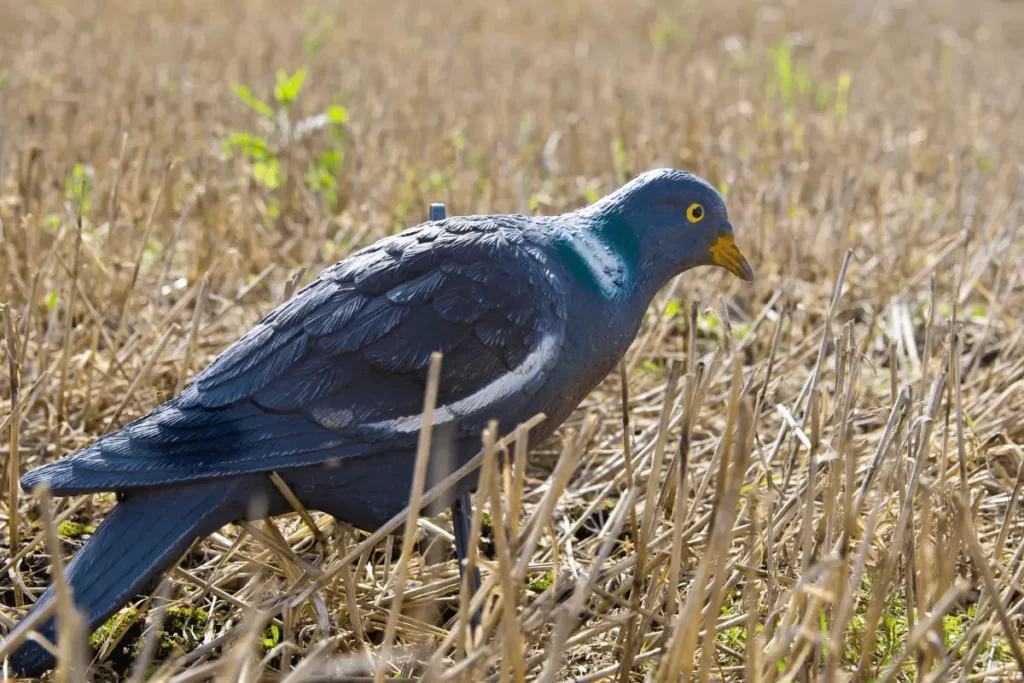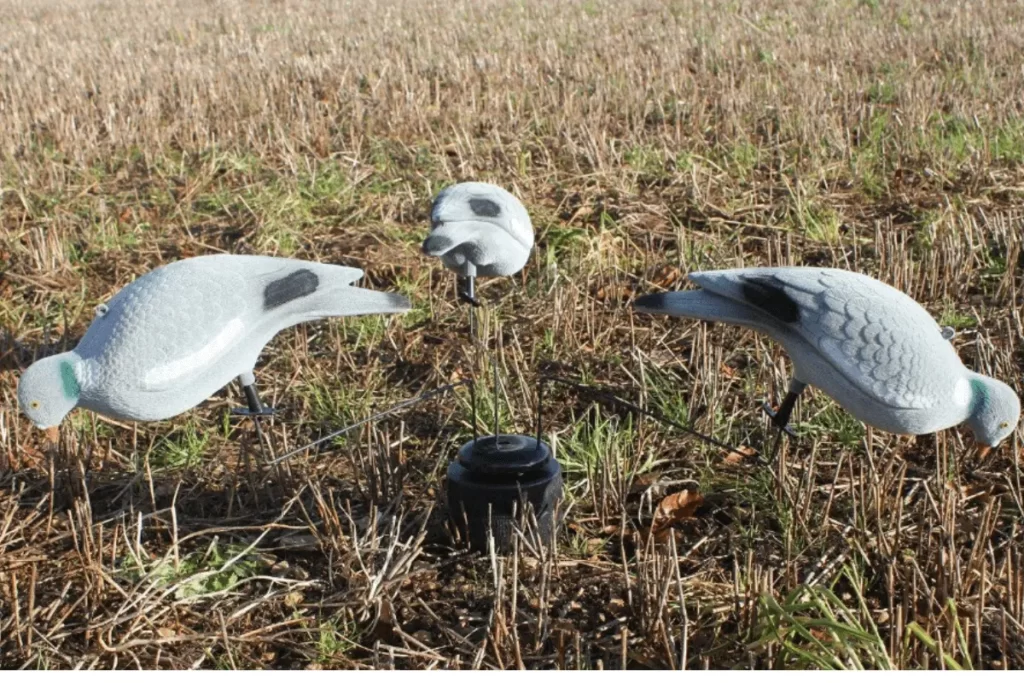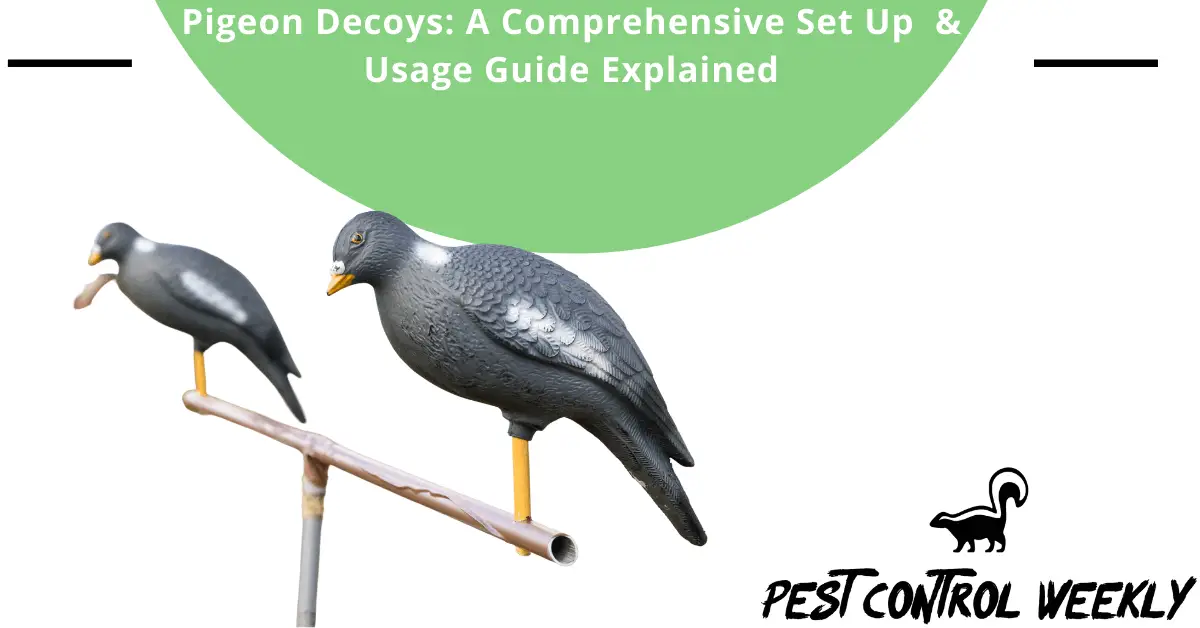Pigeon population control is quite an issue for many people. In most cases, especially for farmers, they have to resort to shooting them in order to prevent damage to crops.
Woodpigeons can be quite a nuisance for farmers. They enjoy eating brassicas and are known to descend in a huge flocks resulting in devastating loss. Pigeon shooting is done in different ways in different seasons.
It is a skill that takes time to learn and demands a number of skills. Pigeon decoys are essential to pigeon shooting and they have come in handy for many farmers.
What is Pigeon Decoy?

It is made with a lot of care and attention to detail to look and act like a real pigeon so that other birds will think it is one of them. Its goal is more than just to look like a pigeon. It is a strategic way to attract pigeons for various reasons, such as ornithological research or ethical hunting. The Pigeon Decoy is usually made of light, durable materials, and it is carefully painted and shaped to look like the species. It is an important tool for any devoted bird watcher or hunter.
Pigeon decoying is a process of watching the birds’ flying patterns, analyzing the direction of the wind, and then placing around several decoy pigeons in specific patterns to attract the pigeon to your range and target zone. These pigeon decoys are “fake pigeons” whose role is to attract other pigeons to your target area.
The Pigeon Magnet

The pigeon magnet is one of the most used pigeon decoys. This decoy usually has two or four decoys that are attached to a motor. This motor makes the decoys seem like they are flying around in a circle to convince the other pigeons that they have found a suitable feeding area.
The Pigeon Magnet is not only used by hunters but also by scientists who want to learn more about pigeons by observing their behavior in a laboratory setting. Its hypnotic appeal is an appealing signal for these urban pigeons, making it a vital tool for pigeon lovers.
Setting up Decoys
Setting up decoys is an art that takes practice. There are certain rules to be followed in order to attain success.
Ideally, you are supposed to set up the decoys in a U pattern, and you should place yourself in such a way that the wind is behind you. This way, the birds will be coming directly towards you.
Site Selection: The first step in putting up decoys is finding the best spot. Investigation and careful monitoring are necessary. Try to find places where the birds go regularly to eat, drink, or sleep. The atmosphere should be similar to the bird’s native habitat to make it feel comfortable.
Species-Specific Decoys: Select decoys that mimic the species you want to attract in. This includes making sure the decoys are the right size, color, and even position. Combining moving and still decoys increases their realism, convincing the birds that they are actually part of the flock.
Formation and Spacing: It is very important where you put your decoys. Put them together in a way that mimics nature, taking into account the habits of the various species. Leave enough space between each decoy to make the scene less crowded and more inviting to birds.
Visibility: Make sure that your decoys are noticeable from the air. Place them where they will receive the most light and where there is the least amount of above foliage. The ability to attract birds relies on their being easily seen from afar.
Adapt to the Conditions: Adjust your plans based on the forecast. To attract birds that typically land against the wind, you may, for instance, position your decoys so that they face toward the wind.
Constant Evaluation and Adjustment: It’s important to evaluate how well your fake setup is working on a regular basis. Be ready to try various decoy placements and patterns if the birds aren’t showing up. Remember that the habits of birds may shift with the seasons.
Do Pigeon Decoys Work?
Wood Pigeons like to flock together; therefore, they are more likely to be attracted to an area where they see other pigeons.
By using a dozen decoys and setting them up in the correct manner, the pigeons will be convinced that they have found a good feeding spot in the field. All you’d have to do is position yourself strategically to shoot the pigeons.
The success of the decoys will depend mainly on you as well. Pigeons are pretty intelligent, so they will not fall for it if the pattern is even slightly off.
Additionally, your endeavors will not be successful if you just set up the decoys and then stand in plain sight. If the pigeons spot you, they will steer clear of your location. This will place them out of your target zone and ruin the whole plan.
Pigeons have excellent eyesight and are capable of detecting movement from afar. To ensure the success of your decoying, you can choose to disguise yourself or creatively come up with a camouflage shooting hide. This can be achieved using camouflage gear or even foliage to blend into your environment.
When you notice the bird coming in, remain calm and hidden. It is crucial to remain still and wait for the right moment as any slight movement will scare the pigeon and have it scampering away before you have the chance to shoot it.
Check Also: Will Dove Decoys Work For Pigeons
How Many Pigeon Decoys Should I Use?
While most people recommend that you use twelve decoys, others feel this may not be necessary. Setting up decoys does not mean that they will work one hundred percent of the time. Other factors come into play that you should consider. Where you set up is very important.
Experts advise that you should do more recon exercises to learn the behavior of the pigeons. Use different numbers and types of pigeon decoys to find out what works for you.
If you take your time and select a place where pigeons frequent, you can be sure to get several kills in a short time.
There could be hundreds of pigeons in the field, and you could still miss one kill. Always remember that all situations are unique, and your improvisation and critical thinking skills will help you improve your efficiency.
You could begin with a dozen decoys and adapt to the behavior of the pigeons. You could consider using different decoys like flappers or a rotary device that will make it easier to attract any pigeon that flies overhead.
Most retailers sell pigeon decoys in dozens which may hint that you can get any number of pigeons with just that.
Knowing how to use the decoys, doing recon, and improving other skills will reduce your reliance on many decoys. You can also decide to pack light and only bring two floaters with decoys or dead pigeons on them.
How Do You Make a Pigeon Decoy?
Pigeon decoys that also flap are better at attracting pigeons closer to your hide so that you can shoot them at close range.
Whatever decoy pattern you choose, you can be sure to attract a number of pigeons using these homemade flapping pigeon decoys mounted onto a pigeon magnet. This decoy could also be used with a floater facing the wind.
Here is a simple step-by-step process you can use to create homemade flapping pigeon decoys
To start, get a pigeon decoy head from a worn-out decoy.
2. Find 3 millimeters of lightweight Acrylic plastic.
3. Using this, cut a simple shape for the body, then attach it to the decoy head.
4. Draw the design of the decoy onto a piece of roofing under-felt or any other light and flexible material.
5. Cut the basic shape of the decoy with these dimensions. Twenty-four inches from the tip of the right wing to the tip of the left wing. Fifteen inches from the neck to the tail.
6. Cut out the laminating plastic used on binder books and cut out the body and tail shape.
7. Sew the plastic onto the underside of the cutout to reinforce the body and tail, except for the wings.
8. Cut out two parallel strips from the leftover roofing underfelt and treble it over. Stitch these to the front of your wings in a straight line where the carbon rod will go.
9. You can now paint the decoy to resemble a pigeon using white and black paint. Include white wing bars and darker strokes of grey to make your decoy look like a pigeon. Start with whiter colors and progress towards darker shades.
10. Once the paint has dried, you can attach the decoy head to the material using small cable ties.
11. Cut the carbon rods to an appropriate length. Use 1.5-millimeter carbon rods for better results with moderate wind speeds.
How To Use A Pigeon Decoy?
Using pigeon decoys may not be as easy as you may presume. Your goal should be to bring the pigeons close enough to you so that you will not have a hard time shooting them down.
If you have the wrong setup of pigeon decoys, the pigeons will land out of range. Your first consideration should be on wind direction before you even find a place to set up your decoys. You should always ensure that the wind is on your back because pigeons fly into the wind when they land.
There are a variety of common patterns that you should look at. You can also decide to use a different pattern when one is not working for you. The key to success is using an appropriate configuration with all these factors taken care of.
If you ever feel lost, you can always rely on information from this article or others like it on the internet on types of setups that are effective.
You should consider using different colored decoys to improve the chances of pigeons noticing your setup and flying to it. Decoy placement is one of the critical determinants of your success.
Conclusion
Pigeon shooting requires dedication and planning if you are to do it effectively. This means that you should get everything right, including the location of the setup, the type and effectiveness of your decoys, the decoy configuration you use, and the number of decoys.
You should balance out these factors to find out which arrangements and sites work best for you.
Decoys are very easy to make at home, and you do not have to buy expensive ones to begin shooting pigeons effectively.
FAQs
What Do Pigeon Decoys Do?
Pigeon decoys attract real pigeons by mimicking their movements and appearance. These fake pigeons look just like real pigeons. This gives the real pigeon group a sense of safety and connection. In reality, they are a trick meant to mimic how pigeons act naturally, making real pigeons think they are approaching friendly people. Pigeon decoys are mostly used by bird hunters, wildlife photographers, and researchers to engage with birds without disturbing their normal routine or making them afraid.
What Are Decoys Used For?
Decoys are used as advanced strategies in a wide range of fields, such as hunting, wildlife study, and photography. They are made to look and act like a certain kind of animal, leading that animal to believe it is one of its own kind. By creating this trick, people can observe, study, photograph, or hunt the targeted animal as it approaches the decoy. In a way, decoys are like a bridge that allows people to connect with different species in their natural habitats without getting in the way.
What Is A Decoy Bird?
A decoy bird is an artistic copy of a particular bird species that is made to look and act like a real bird. These decoys are often made of wood, plastic, or other long-lasting materials and are used to attract real birds. Decoy birds create the illusion of safety and friendliness, which makes real birds come closer to the decoy and connect with it. Hunting, bird watching, wildlife photography, and research use them to study birds in their native habitats.
Do Pigeon Decoys Contribute To Wildlife Conservation?
Pigeon decoys can indirectly help protect wildlife. Decoys make researching and photographing pigeon species less disturbing than trapping or upsetting live birds. They make it less important to use methods that could hurt birds to draw or catch them. This helps keep birds’ natural behavior and reduces stress in wild populations. However, it is essential to use decoys ethically, putting the safety of the birds and their environment first.
